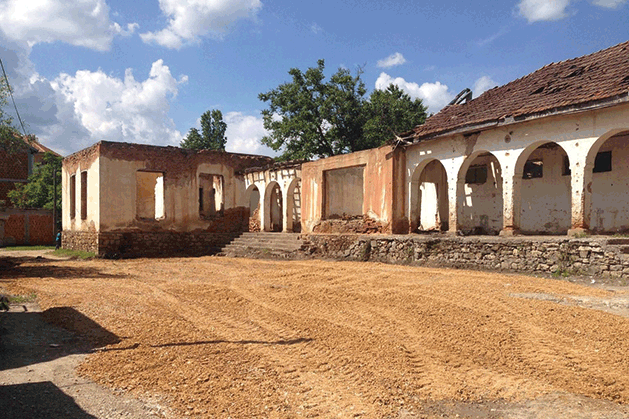The remains of the House of Culture, which Halilaj is working to restore
Photo: Studio Petrit Halilaj
“What I remember is different from my mother and my father,” says the Kosovar artist Petrit Halilaj. “They grew up with theatre and cinema, but I never saw that. For me, this House of Culture was a ruin in a place about which they told us ‘don’t go’.”
Built in the 1950s, the building Halilaj recalls was the House of Culture in the village of Runik. It encompassed a grand library, theatre, with performances, film screenings and concerts. It closed in 1989 when Kosovo, then an autonomous province within Serbia, was stripped of its legislative and executive powers. School curriculums were changed, and Albanian culture, literature and history were wiped out.
In the years that followed, several resistance movements fought unsuccessfully for independence and, in 1998, Serbian forces began a violent campaign against Kosovo’s ethnic Albanians. Now, to revive the cultural scene that vanished under Serbian rule, Halilaj is leading the restoration of the Runik House of Culture (RHoC) with the help of a €700,000 government grant.
In May the UN declared 11 July an annual day of remembrance for the victims of the 1995 Srebrenica massacre, honouring the more-than 8,000 Bosnian Muslims who were killed there. Halilaj, who experienced the war as a child in Kosovo, welcomes the resolution, and hopes that reviving the RHoC will provide much needed cultural education to an area still recovering from the destruction of its historical sites.
The artist, who has just created an installation for the Metropolitan Museum of Art’s rooftop garden, has long hoped to contribute to Runik’s cultural revival. In 2018 he organised an elaborate performance, Shkrepëtima (lightning), within the ruins of RHoC to spark cultural awareness; the success of the event led the government to reclaim the site.
Five years later, plans emerged to demolish and replace the landmark with commercial buildings. Halilaj campaigned instead for RHoC’s restoration, securing approval from authorities under the condition that his foundation, Hajde, supported its development. The concept design for the restoration is the subject of an open competition, with a deadline of 17 July.
A cultural programme is already planned for the site during its restoration phase, and a team is preparing for the centre’s opening. The new venue will feature a theatre, library, workspaces and a museum for Runik’s notable Neolithic archaeological finds. Many of these artefacts will be on show for the first time, having previously been consigned to private homes due to the lack of suitable exhibition space.
Halilaj aims to also include the area’s Serbian community in the centre’s programme. He believes this will be vital for community resilience and sees the revival of the RHoC as essential for providing a platform for expression and healing. “What we have to learn, even today, is that taking away freedom of speech brings us nowhere,” he says.
During the war Halilaj and his family were displaced. On a brief return to his family home, he remembers living with around 50 other people. Their short respite ended when his father, along with other ethnic Albanian men, was taken away by Serbian forces. Displaced once more, Halilaj found himself in the Kukës II refugee camp in Albania. The psychologist Giacomo “Angelo” Poli encouraged children there to express themselves through drawing. Without cameras or mobile phones, Halilaj felt compelled to depict the atrocities he had witnessed in detailed drawings. These inspired the installation at his first UK museum solo show, Very volcanic over this green feather, at Tate St Ives in 2021. “I’m convinced [that drawing in Kukës II] kind of saved my life,” the artist says. “In a spiritual sense and the idea of connecting to someone in a language in which I feel so comfortable, which is drawing.”
For now, Halilaj is excited by the prospect of the people of Runik regaining access to cultural programmes. “The truth is recognising this: to me it is not to have a winner or a loser,” he says. “This is a first step towards reconciliation and a better future, because otherwise people will always bring frustration, and the argument will never be closed.”
• Petrit Halilaj: Abetare, Metropolitan Museum of Art, New York, until 27 October

